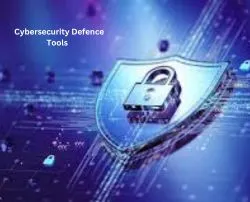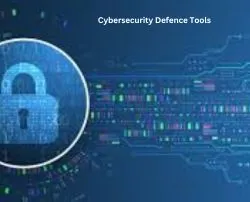Introduction
Why Cybersecurity Still Matters in 2025
This is why Cybersecurity Defence Tools should be considered not only useful but also necessary. Honestly speaking, 2025 is no longer the future. It’s here. And along with-it cybercriminals have brought it to a serious level. You can be a target no matter what you are doing with your time: running a business, freelancing, or even scrolling social media. No joke. The threats that we are experiencing today are not the same as what we experienced five years ago. They are cleverer, quicker and more devastating. Therefore, when you are still using the same “123456” password, you are effectively inviting trespassers into your computer.
The Rising Threat Landscape
Information breach, phishing schemes, ransomware attacks, they are not just the nightmares of tech news. They happen every single day. However, this is the trick: tools are not sufficient. You should have a balanced approach in order to create a digital fortress.
It is time to explore 7 realistic and effective methods of upgrading your defences in the current year.
1. Embrace AI-Powered Cybersecurity Defence Tools

How AI Detects Threats Faster Than Humans
Visualize a guard dog which does not blink. That is AI when it comes to cybersecurity. It offers real-time tracking, immediate threat identification and intelligent analysis with AI-enhanced tools. In short, a super-sleuth who does not drink coffee.
These tools do not sit back and wait until things go wrong, they are actually predictive and preventive. They detect abnormal behavior; they locate specific malware variants and even evolve to new threats.
Real-Time Monitoring and Predictive Analytics
The magic ingredient in this case is machine learning. These systems process massive amounts of information in a lightning speed. They put red flags on suspicious activity before it becomes a full-blown violation.
By 2025, in case you are not already using AI-powered Cybersecurity Defence Tools, you are already falling behind.
2. Implement Zero Trust Architecture (ZTA)

Never Trust, Always Verify
Lay aside the ancient credo but prove. There is no trust in Zero Trust it is verify. That is, all devices, users, and applications have to keep on demonstrating that they are authentic.
It is the bouncer at a nightclub who wants to ensure that every 10 minutes you are who you are and not just a fake card.
Why ZTA Works in Hybrid Work Models
Admittedly, it is not leaving in the near future. And Zero Trust is made to suit that world. It ensures that the employees in Bali, Berlin or Bangalore get the same degree of secure access as a person in HQ.
Combine that with trusted Cybersecurity Defence Tools and you are good to go.
3. Prioritize Multi-Factor Authentication (MFA)

Passwords Are Not Enough Anymore
When using passwords alone in your system, you are walking on a thin thread and have a net. MFA also introduces an additional feature: text code, fingerprinting, or confirmation in the application.
You can make it out to be your second lock–one lock is not enough to cut it anymore.
MFA for Teams, Clients, and Systems
Use MFA across the board. That includes those of the administration panels, emails, cloud applications and even customer login. MFA is a default on most of the Cybersecurity Defence Tools currently available.
4. Keep All Systems Regularly Updated

The Dangers of Outdated Software
You would not drive around with bald tires and broken brakes, would you? Why not run out-of-date software that can be easily compromised by a hacker?
Late updates also have a high rate of vulnerabilities which are favoured by cybercriminals.
Automating Updates with Cybersecurity Defence Tools
Fortunately, auto patching is now available in most Cybersecurity Defence Tools. That is, your system is updated automatically in the background – no longer do we have to see those annoying pop ups to remind us of a system upgrade.
Fix it, lose it and be insured.
5. Educate Your Employees Continuously

Your Team is Your First Line of Defence
Majority of the attacks start with a mere clicking. An e-mail that sounds like it was written by the HR? Boom. That’s how ransomware enters.
Raise your department as a digital army. Provide them with instruments, examinations, and real case scenarios.
Simulated Phishing Attacks & Regular Training
Test awareness using platforms that send phishing emails that are fake. It is the fire drills but on your inbox. In addition, numerous Cybersecurity Defence Tools include training modules these days.
6. Encrypt All Sensitive Data

What Happens If You Don’t Encrypt?
Suppose your client information is leaked – and it is plain text. Not only embarrassing, that would be costly and legally hazardous as well as reputation-destroying.
Encryption is the scrambling of your data and thus only authorized individuals can decrypt it. Even when hackers lay their hands on it, it is gibberish to them.
Choosing the Right Encryption Standard
Look for AES-256 encryption. It’s the gold standard.
Most highly-rated Cybersecurity Defence Tools will offer default encryption privileges; however, you cannot afford it, check your settings at all times.
7. Use Robust Endpoint Protection

Every Device Is a Potential Door
That laptop your intern uses? That’s a possible entry point. And your phone, and your smartwatch and your coffee machine (when it is smart).
Each of these access points is secured by endpoint protection.
Endpoint Security with Centralized Control
The most efficient tools will enable you to monitor and control all endpoints using a single dashboard. It is possible to quarantine suspect devices or wipe lost devices at a distance.
In the modern Cybersecurity Defence Tools, this functionality is complimented with malware protection, device encryption, and integrating firewall features.
Bonus Tip: Monitor the Dark Web

Why It’s Crucial to Know If You’ve Been Breached
The Importance of Understanding Whether or Not You Have Been Breached.
This is the frightening aspect here; your login details could already be sold on the dark web. Yikes.
You will never know until it is too late unless you monitor.
Dark Web Scanning Tools
The good news? Dark web monitoring is present in many current Cybersecurity Defence Tools. You will be notified when your personal information is being sold in hacker markets- you will have time to do something.
The Role of Cybersecurity Defence Tools in 2025

The Future of Automation and Intelligence
In 2025, it is all about automation of cybersecurity. Man is no longer able to match the size and rate of attack.
These solutions give AI powered automation, behavioural analysis, dark web scanners, and endpoint protection among others.
How to Choose the Right Tools for Your Business
Your industry and size are the first ones. A freelance designer will not require the tools that a fintech company would require. Search the tools which provide scalability, appropriate customer service, and simple integration.
Don’t skip – Cybersecurity Defence Tools are your on-line policy.
Conclusion
Admittedly, cyberattacks are here to remain. However, this does not imply that you have to live in fear. By employing a clever strategy, appropriate training, and the appropriate Cybersecurity Defence Tools, you will be able to develop a robust and future-proof defence system.
Start small. Enable MFA. Keep everything updated. Train your team. Encrypt your data. A single step brings another brick to your wall.
In 2025, it is not enough to keep hackers out of the shop, but three steps ahead.
FAQs
1. What are the best cybersecurity defence tools for small businesses?
Some of the best ones are Bitdefender Gravity Zone, CrowdStrike Falcon, Norton for Business, and Fortinet. Search in tools that can be installed easily and as your business grows.
2. How often should I update my cybersecurity tools?
A majority of the tools allow a manual update, however, when it comes to handing things yourself, a weekly or monthly update is at least the goal.
3. Is Zero Trust necessary for every business?
Yes, particularly when you are working in a distance or a hybrid model. Zero Trust can be graduated to suit any business.
4. Can I rely solely on antivirus software?
Nope. Antivirus can be considered to be only one slice of the pie. Firewalls, endpoint security, encryption and training of users will also be needed.
5. What is the difference between endpoint protection and a firewall?
A firewall is used in the regulation of external traffic attempting to penetrate your network. Endpoint protection is used to secure your network devices. The two are necessary to be fully covered.






